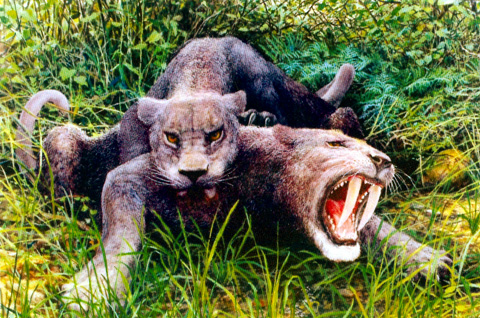The Language of Deep Time: Loren Eiseley’s “The Innocent Assassins” and the Science of the Prehistoric Plains
 “The Innocent Assassins” by Jan
Vriessen. www.eiseley.org
“The Innocent Assassins” by Jan
Vriessen. www.eiseley.org
Grade Level
7 – 12
Overview
Nebraska’s own Loren Eiseley was an anthropologist, academic, and writer who was widely known for his nature writing and poetry. One of Eiseley’s most beloved poems, “The Innocent Assassins,” imagines the battle between two sabertooth cats, the fossils of whom Eiseley discovered in 1932 at Wildcat Ridge in Bayard, Nebraska. Remarkably, the fossils reveal an epic battle and agonizing death for both cats, as the fangs of one are forever impaled in the leg of the other.
A study of “The Innocent Assassins” reveals a wealth of information about the prehistoric plains, and the philosophizing of modern man. This unit will open the doors to the deep past by excavating Eiseley’s language to find the scientific truths waiting to be discovered within.
Objectives
In this unit students will:
- identify scientific and/or historical facts in a poem
- select a scientific fact for further study
- analyze and evaluate research sources
- relate the findings of their scientific study in a poem
collaborate on a written poetic piece
Required Materials:
- “The Innocent Assassins” by Loren Eiseley
- Internet or print research sources
Step-By-Step Procedures:
(This activity could take one class period, or several class periods, depending on teacher objectives for the unit.)
- Instruct class to listen to the poem “The Innocent Assassins” read aloud while following the text in print.
- Discuss the meaning of the piece. Discussion questions might include:
- Why does Eiseley believe the cats to be “innocent assassins”?
- Eiseley claims that man is a “dark assassin of his kind.” What might the poet mean by this? How might our understanding of “man as assassin” be different today than Eiseley’s was 70 years ago?
- Direct students to annotate the piece, identifying words or phrases that reference or
reflect some scientific aspect of the situation. Found words and phrases could include:
- sabertooth cat
- ancient
- cellars of dead time
- forces that heaved mountains up from the sea /
- mountains thrust up
- Cretaceous sea
- 40 million years
- [animals like the sabertooth] suddenly were gone
- mountains worn down
- . . . for the beauty gone
- earth’s inanimate core
- atavists
- Discuss the meaning of these words and phrases from a scientific point of view.
- What does each mean literally?
- What images are suggested?
- Each student should choose one scientific aspect from the poem to research with respect
to
the specific deep time history of the plains region. Research queries might include:
- When did sabertooths live in the North American plains?
- How did North America’s plains sabertooths survive? What did they eat? What ate
them?
How are the plains geologically different today than in the time of the sabertooths? - What other creatures and plants were thriving in the plains 40 million years ago?
- After completing his or her research, each student should compose a haiku poem about his or her research subject, illustrating the most important aspects of their findings. Some sample pieces are offered below:
- Students should work in small groups or as a whole class to compile their haiku poems
into
a longer collaborative piece. Consideration should be given to the order of the individual
haiku in the longer piece.
- Which pieces fit naturally together?
- Which would be a compelling opening?
- a powerful ending?
Sabertooth
Sabertooth, you beast
predator of the prairie
then, suddenly gone
Deep Time
What we know as plains
was once mountainous and sea.
What might we soon be?
Extinction
We’ll never know you,
creatures that roamed ancient plains.
Bones tell your story.
A Fun Follow-up Activity:
Use “The Innocent Assassins” as a mentor text by having students imitate Eiseley’s form in a poem that imagines the plains region 40 million years from now. What type of being might stumble upon our fossilized remains? In what position or situation might that being find us? What will that being learn about our world from the artifacts we leave behind?
This lesson meets the following Nebraska State Standards:
- LA 10.1 Reading: Students will learn and apply reading skills and strategies to comprehend text.
- LA 10.2 Writing: Students will learn and apply writing skills and strategies to communicate.
- LA 10.3.2 Listening: Students will develop and demonstrate active listening skills across a variety of situations.